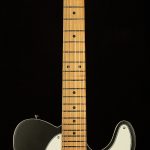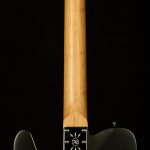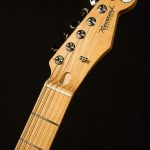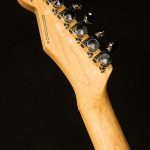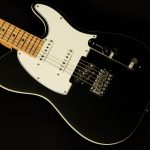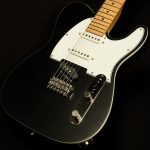Reverend Pete Anderson Signature Eastsider Baritone
Overview Video
Enter the Baritone Zone
Pete Anderson is a Grammy award-winning producer and sideman, and he laid down countless incredible guitar tracks as Dwight Yoakam's right-hand man, but his new signature Baritone guitar may be his greatest accomplishment yet! After the runaway success of Pete's other signature Reverend guitars, a baritone was the logical next step, and Joe Naylor delivered the goods. A few minutes of picking were all we needed to realize that the Pete Anderson Eastsider Baritone is an incredibly inspiring, ridiculously versatile instrument with about a bajillion potential applications. Let's take a closer look and see why it sounds so awesome!
Baritonewoods
First things first: the Pete Anderson Baritone's body is made of korina, which has QUITE a powerful voice. Korina has the roundness and warmth of mahogany, but its top end is livelier and it has a bit more midrange bite. The chambers also add a bit of extra percussiveness to the attack, a touch of fatness to the lows, and a sprinkling of airy brilliance to the highs. This body works wonders with the roasted maple neck. Roasted tonewoods have a drier, more vintage-flavored sound. In particular, roasted maple necks act like big 'ol wooden tuning forks. They produce woodier tone with greater clarity--a necessity for a baritone! In conjunction with the chambered korina body, the roasted neck helps make this guitar sound fat, warm, and clear, just like a baritone should.
Bari, Bari Good Tones
The electronics on this baritone beast allow you to cop a wide swathe of low-tuned sounds. The two Salnico single-coils in the neck and middle positions have plenty of glassy, warm lows and vocal midrange quack, while the Talnico in the bridge position gives you plenty of woody twang, midrange punch, and high-end sizzle. The out-of-phase switch on the tone knob also gives you the option to cop some sparklier, quackier tones in positions two and four.
We have to turn to hypotheticals to truly convey the delightful sound of these pickups, though. Imagine playing a Jimi Hendrix 45 at 33rpm, slowing down the recording and pitching everything down. Essentially, that hypothetical Strat fantasy is how the neck and middle positions sound. Warmer, fatter, and deeper, but with an undeniable golden hue in the highs. Swap out the Hendrix record for an early Zeppelin record and you'll get a rough idea of how the Talnico bridge sounds (remember, Jimmy Page used a Tele on the first four Zep records!). Or, to pull an example from another genre, imagine Luther Perkins's tone on all those Johnny records but deeper and woodier.
Everybody Twang Chung Tonight
Often times, country players like Pete Anderson will use a baritone guitar to play bassy "tic-tac" lines full of bouncy roots and fifths, or to play twangy spaghetti western-style leads. The Pete Anderson baritone certainly excels in these applications, but it can do so much more! Its warm, clear voice and excellent note separation allow you to play big 'ol six-note voicings and hear every part of the chord. So, you can essentially use it as a different flavor for rhythm guitar tracks. The 10"-14" compound radius on the fretboard also allows for tremendously expressive lead playing because you can still bend away to your heart's content. In fact, even though the Pete Anderson Signature Baritone has a longer 28-5/8" scale length, it feels so natural that it's easy to forget that you're playing a baritone (well, at least until you hit the low string and feel the ground shake!).
Chugga Chugga, Dude
Speaking of making the ground shake, I would be remiss if I failed to mention how amazing this guitar is for heavy music. Though Pete Anderson may be a country guy, his signature works great in gnarly high-gain settings because of its combination of clarity and warmth. It can handle lots of distortion, but it doesn't really get harsh. Through a Friedman Small Box combo with the gain on ten, I had a great time playing everything from Sabbathian heavy blues to Kyuss-esque sludgy riffs to punky Deftones-style chugging. Frankly, all the metal dudes at Wildwood are utterly enamored with this guitar! The fact that it works so spectacularly well in a genre far outside its intended wheelhouse is a testament to its amazing versatility.
Tune Low and Enjoy
We are proud to present such an incredibly inspiring instrument to our exceptional customers. The Pete Anderson Eastsider Baritone's boutique build quality, superb playability, and intoxicating sonic cocktail are sure to provide you with plenty of joy, and we know you'll fall hopelessly in love with it as soon as your pick touches the strings.
Specifications:
| Brand | Reverend |
|---|
| Model | Pete Anderson Eastsider T Baritone |
|---|---|
| Finish Color | Satin Midnight Black |
| Weight | 8.11 lbs. |
| Body Wood | Solid Korina, Chambered Under Pickguard |
| Neck Wood | Roasted Maple |
| Neck Shape | Medium Oval |
| Neck Dimensions | .810 1st - .830 12th |
| Strings | SIT Custom 11.5-56 Set Tuned to C Standard |
| Fingerboard | Roasted Maple |
| Fingerboard Radius | 10-14" Compound Radius |
| Inlays | Dot |
| Scale Length | 28 5/8" |
| Width at Nut | 1.693" (43mm) |
| Frets | 22 Medium Jumbo |
| Pickups | Reverend Talnico-B (Bridge), Reverend Salnico-N (Neck and Middle) |
| Controls | Custom Volume and Tone, Push-Pull Out-of-Phase Switch, 5-Way Selector |
| Bridge | Wilkinson WV6 SB (Steel Block) Tremolo |
| Tuners | Reverend Pin-Lock Tuners |
| Case | Reverend Cases Are Sold Separately But You Can Add One to Your Order By Checking the Box Right Above the "Add to Cart" Button |
Why Order from Wildwood Guitars?
An instrument from Wildwood isn't just an ordinary guitar. It's your guitar. Each and every instrument we sell includes a full, point by point setup, an exhaustive evaluation, and expert shipping procedures, with first class, industry leading standards from start to finish. Why? Because you deserve it.Click Here to learn more about what makes a Wildwood instrument so special...





